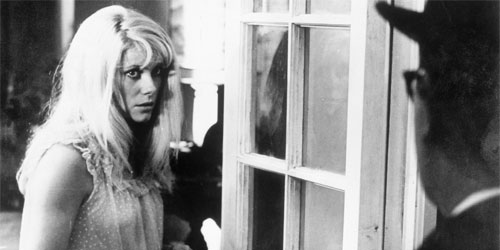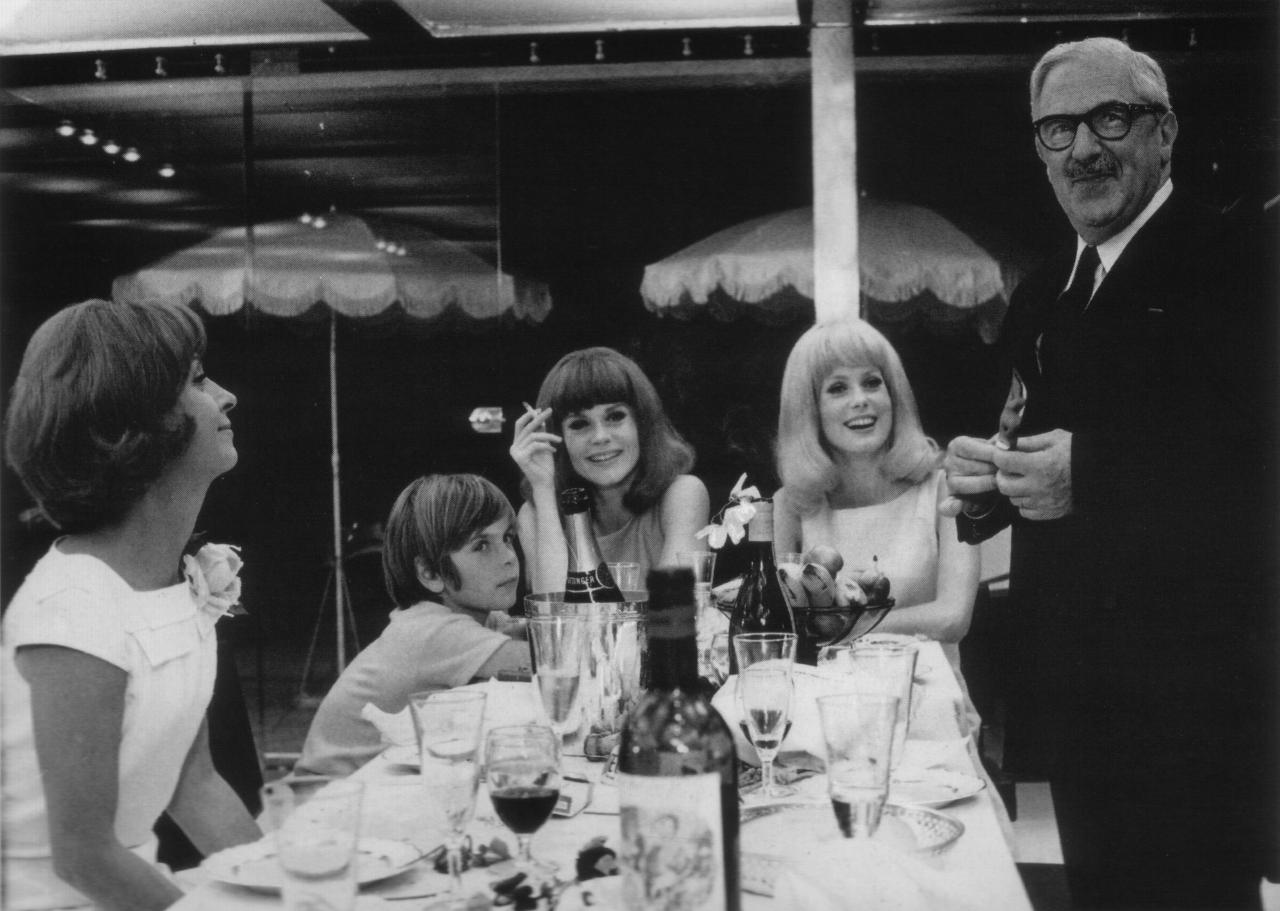This guest post by Johanna Mackin appears as part of our theme week on Violent Women.
When Carol, the demure and unassuming young beautician at the heart of Roman Polanski’s surrealistic thriller Repulsion begins to lose her grip on reality, she externalises a deep fear of men into acts of fatal violence. Some of cinema’s most symbolically layered female characters are seen to present patterns of shy and socially anxious behaviour that belie murderous impulses, but who are these timorous killers, and what archaic chains of fear are made manifest in the violent outbursts they are given to?
Carol (played by Catherine Deneuve), is irretrievable from her shyness. She looks down as she walks, her manner is subdued and often sullen, and she frequently appears lost in a world of her own. Her speaking voice is soft and she speaks little, her movement slowed by the burden of fear, and she passes across things so lightly and interacts with the world so delicately that she can barely be seen to leave a trace upon it. Her fragility and reservedness (which as we will see provide a crucial, if unsustainable, defence against threats to the self), are only breached when outside influences encroach more than the barely tolerable amount she has come to live with, and these cracks in her armoury, which give way to hallucinations of violent sexual abuse, culminate in a double androcide.
The eye we see in the film’s opening credits belongs to Carol and encapsulates her relationship to the internal and external worlds. To outside observers, Carol’s large, doe-like eyes are a signifier of her feminine allure, but, as is made palpable to the viewer, they also house her intense fear and constitute a deceptive barrier against the malignant traumas that disturb her internal world.
Pioneering object-relations psychoanalyst Melanie Klein expands Freudian notions of death instinct, identifying that “anxiety has its origin in the fear of death,” which she sees as an impervious truth for every human. For the infant, the ambiguity of the object world represents a deathly threat to the self that destruction is projected onto, turning it into an external representation of the death instinct, which is introjected as internalised self danger and then projected back out into the external world. Constantly mediating a fear of the outside and a fear from within, external dangers are thus intensified due to internal fear, but the introjection of this harmful danger also intensifies “the perpetual inner-danger situation.”
The threat posed to Carol’s ego by the men she comes into contact with therefore greatly exacerbates her internalised danger, and thus the fear of death, or death of the self, given that selfhood is the only conduit through which we live in the world. Of course, real and imaginary threats can demonstrate a similar impact upon the individual, and in Carol’s case she is presented with significant instances of both, from the direct misogyny of men encountered, to imagined cracks in the walls of her apartment worsening outside of her control.
Terror management theorists developed the idea that “we humans feel fully secure only if we consider ourselves valuable contributors to that world we live in,” the world of meaning we have created to defend against the anxieties of death. A sense of our value within the world (or “self esteem”) is established in our interactions with others, and the extent to which we are able to be successfully incorporated into the dominant worldview. Studies following this position have shown that it is through elevated self esteem that we can most easily evade the fear of death. Carol’s self esteem, already negligible at the start of the film, is systematically shattered throughout the course of its events as she is leered at, coerced into romantic situations against her will, and scolded for her demeanour by a succession of people. A fundamental paradox at Carol’s centre is that her aesthetic presentation makes her appear acceptable to society, while her turbulent sense of self is greatly at odds with one which can be enjoyed as a fear-abating continuation of the dominant ideology.
In an edifying essay about the impeachment of the commercial skin industry on the way we view our own bodies, authors Kenway and Bullen highlight a crucial link between the perfect body image, and the sociological pedagogy of a myth that anything which threatens it possesses an abject quality. Naturally, these prescribed notions of attractiveness impinge greatly upon a whole society. Failure to properly conform can be taboo or prey to a litany of prejudices; compliance, as noted in Carol’s case, can elicit unwanted attention and expectations. This is epitomised in her sister’s lover’s view of her, as both “the beautiful younger sister” and someone who “needs to see a doctor,” when her failure to meet his expectations of polite social interaction threatens the stability of his own tentatively compiled defences against death anxiety.
The events that precipitate Carol’s unravelling stem from her sister’s involvement with a married man and subsequent holiday. Carol is reliant upon the protective forces exerted by her sister’s presence, and when the barrier of their private apartment is punctured by an unwanted male (she throws his belongings away after hearing her sister having sex with him), her abject defences necessarily harden, so that what little self is left may not be stolen from her. When she is left alone in the house, she meditates upon a family photo, which is returned to for clarity of motive at the end of the film. It features Carol as a young girl, lingering defensively in the background and casting a hateful stare at a nameless patriarch on the right. The implication, reinforced when the photo appears again as the final shot of the film, is that Carol was sexually abused as a child, and this is what has prompted her intense mistrust of men and series of harrowing rape hallucinations.
This internally harmful repulsion felt toward men, which was engendered in Carol at such a young age, has been unable to heal owing to constraints of society and the continual reinforcement of negative patriarchal behaviours. Colin exerts his entitlement over her (despite voicing his recognition at one point that “it’s all so sordid”), eventually breaking down the door of her apartment through sexually agitated aggression. Her landlord attempts to repeat the abuse she suffered as a child, repelled only by a fatal outburst. Even less overt threats such as cat-calling in the street and sexualised derision from other men in conversation (“Cinderella,” “Little Miss Muffet”) belie a menacing claim to women’s bodies, which asserts that Carol’s fear is not at all unfounded.
Whilst, as Klein suggests, externalisations of fear are often our most powerful therapeutic defense against it (via artistic expression, for example), Carol’s freedom to communicate is so muted by those around her, who will not weather her extremes of anxiety, that it is impossible for her to manage this fear in a healthy way, and so it spills over (like the filled bathtub into which her first victim is decanted) as an even more abject threat to be internalised once more, intensifying her removal from reality. People project onto her a social conformity that her life experiences render her incapable of meeting. Her trance-like episodes are condemned by customers and colleagues at work; her desperately relied-upon sister curtly dismisses her deep paranoia; she is told to not “look so mis’” by a well-meaning friend. This projected impediment of ill-fitting normalcy onto Carol sends her deeper into herself, manifesting as a timidity which in turn fosters more hostility from the external world which, rather than providing a patient and therapeutic space for Carol to talk into, imposes desired behaviours onto her. Her main pursuer, Colin, purposefully ignores her silence and negative body language as he repeatedly makes unwanted advances upon her.
Speaking on the development of schizoid states and schizophrenia in children, object-relations therapist D W Winnicott offers that failure of good-enough active environmental adaptation, produces a psychotic distortion of the environment-individual set-up. Relationships produce loss of the sense of self, and the latter is only regained by return to isolation. Being isolated, however […involves…] more and more defensive organization in repudiation of environmental impingement
For Carol, who can be seen to present with an obviously schizophrenic symptomatology, the healthy development of understanding illusion in the external world is distorted, or interrupted by childhood abuse. An incorporation of illusion into the life of a healthy child is challenged as they grow up (think of the tooth fairy, for example), but in the case of Carol the distinction between objective and subjective reality was denied a healthy conclusion by forcing a defensive retreat into a secret, “truly incommunicable” inner world, far removed from external reality. Here her use of illusion takes on more psychotic properties, especially when under duress such as that of her sister’s departure.
Compounding Carol’s fear throughout the film is a plethora of memento mori, which bind events to a sense of impending death. The devouring cracks in the wall; the sounds of clocks ticking and bells tolling at moment of heightened trauma; and finally, the rabbit, a symbol for Carol’s own self death (this is alluded to in talk of her being “strung up” and “all shaking like a little frightened animal”). The rabbit rots away throughout the film, eventually thrown out by the landlord who is then killed after he abuses Carol, thus severing her final defence against the unburdenable traumas of the past and from which she is unable to recover.
Winnicott speaks of the individual as then being able to inhabit a “false self that seems satisfactory to the unwary observer” (however unconvincing, Carol’s prosaic job and her hesitant engagements in conversation with Colin support this). This false self defends fiercely against the core self, “although the schizophrenia is latent and will claim attention in the end.” He describes a loosely organised self in defence against paranoid anxieties as “defensive pathological introversion.” Continuously expelling and incorporating the impeachments upon her secret, incommunicado core, Carol sinks further into a world which is entirely abject and encroaches upon the borders of her existence. This catastrophic entropy and its fatal consequences result in Carol’s defences eventually shutting down altogether as she slips into a kind of catatonic state at the end of the film. Her subjectivity is silenced by society, being deemed unacceptable, and so she has no reasonable outlet but to kill. Others must die so that she does not suffer total self death.
Repulsion is just one representation of the explosive anxieties of women in film. Carrie is perhaps the most famous example of a “timorous killer,” but other notable examples of introverted women being pushed to murderous extremes include Sleepaway Camp, Ms 45, Sightseers, Antichrist, and A Question of Silence, to name a few that are well worth exploring.
What these characters also have in common is an ability to explode and subvert the damaging environments that contain them. Sometimes their murderous transgressions from shyness and anxiety provide them with a kind of psychotic catharsis, and sometimes the consequences present a more abysmal loss of self, but what is consistently gratifying is the symbolic employment of such characters to illuminate the negative effect of a dominant cultural ideology on individuals. In a world ridden with stringent and judgmental expectations, the symbol of the timorous killer should be celebrated as a resistance against cultural order.
Johanna Mackin has recently completed an MA in Contemporary Literature in Culture and currently spends her time coding and writing poetry (the boundaries of which are often blurred). You can find some of her poetry on Instagram, or follow her on Twitter @johannamackin


























